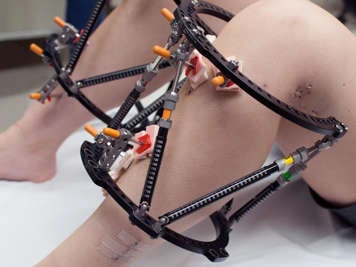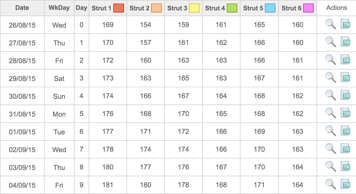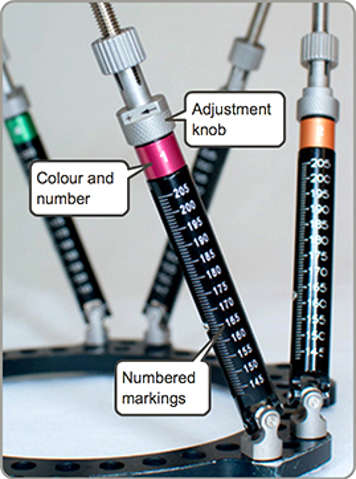
The Taylor Spatial Frame (TSF) is a circular external fixator. It is used in limb reconstruction to gradually lengthen limbs, correct limb deformities or reposition a fractured (broken) bone.
The frame consists of at least two full or partial rings that are connected by six rods. These rods are called struts. Each strut can be adjusted to lengthen or shorten as needed.
It is sometimes possible to use more than one frame on a limb or to correct more than one limb at a time.
How is the Taylor Spatial Frame attached to the limb?
Your child is fitted with the Taylor Spatial Frame during surgery.
First, the surgeon performs an
osteotomy to divide the bone. Then they use metal wires or pins to attach the frame to the limb on either side of the division.
Your child's surgeon will decide the exact shape and type of frame that your child needs after carefully considering the
type of limb lengthening or limb deformity correction that your child requires.
How does the Taylor Spatial Frame work?
Design
The rings and struts of the Taylor Spatial Frame come in many different sizes and can be built to make a frame that fits a limb of any shape or size.
The six struts allow for six different directions of movement of the circular rings. This means that the bones can be lengthened, shortened, angled or rotated into almost any position all at the same time. As a result, the TSF can correct even very complicated limb deformities.
Note: Struts come in different lengths. Your child's healthcare team may need to change them occasionally during clinic appointments to allow the limb to be lengthened or corrected fully.

Programmed adjustments
The TSF comes with a computer program that works out a detailed prescription, or schedule, for adjusting the struts on the frame. It produces this prescription using information entered by your child's surgeon about your child's limb length discrepancy or limb deformity. Adjusting the struts each day according to this prescription will gradually move the bone to its new position.
The computer program can also create pictures showing:
- what the limb looks like before treatment
- what it should look like as the correction continues
- what it will look like when the treatment is complete.
The surgeon can compare these pictures with your child's x-rays before and during treatment. This helps them check that the bones are aligning with each other and healing at the correct pace. It also allows your child's surgeon to adjust the program slightly to make sure the limb heals in the best position.
The Taylor Spatial Frame also comes with a smartphone app to help remind you to make the correct adjustments to the frame each day. This app also tells the surgeon of your progress so that they know that everything is going as planned.
How do I adjust the Taylor Spatial Frame?
Adjusting the Taylor Spatial Frame is very easy. Your child's limb reconstruction team will teach you how to adjust the frame and follow the prescription before your child leaves the hospital.
Starting adjustments

Each of the six struts in the frame has its own:
- colour
- number
- adjustment knob
- numbered markings, much like a ruler.
The surgeon will set the silver markers to a specific number on each strut during your child's surgery. Five to seven days after surgery, you will start to turn the adjustment knobs on the struts. Turning each adjustment knob will make the strut longer or shorter. You can look at the markings on each strut to see the change in length.
The prescription you get from the surgeon will tell you which strut to adjust, when to adjust it and by how much. It will look something like this example.
Turning the adjustment knobs

Some struts have a locking bolt above the coloured marker. You will need to loosen this by hand before you make any turns and then lock it back in place when you are done.
- Each adjustment knob has an arrow and a plus sign on it.
- Turning towards the plus sign (in the direction of the arrow) will make the strut longer.
- Turning away from the plus sign will make the strut shorter.
- You will need to turn the struts three times during the day.
- First session: Turn only struts 1 and 2.
- Second session: Turn only struts 3 and 4.
- Third session: Turn only struts 5 and 6.
Important: Depending on the type of limb lengthening or correction that is planned, you may not need to adjust all the struts. Also, you may need to lengthen some struts but shorten others. Always follow your child's prescription to know what changes are needed.
Checkpoints for adjusting the Taylor Spatial Frame
- Each morning, before doing any turns, check the numbers on each strut to make sure you are starting from exactly where you finished the day before.
- As time passes and your child's prescription continues, the struts may become stiffer and harder to turn. Contact your child's healthcare team if a strut is too stiff to turn.
- Continue following your child's prescription until a member of your child's healthcare team tells you otherwise.
Will adjusting the frame hurt my child?
The frame corrects the limb very slowly, usually only by 1 mm each day, so adjusting it is not usually painful.
Does my child need to take special care with the Taylor Spatial Frame?
The frame is very strong. Your child does not need to worry about breaking or bending it.
Your child will be able to bear weight fully on their limb immediately after surgery and can take part in all their normal activities if they feel comfortable doing so.
Return to limb reconstruction learning hub